With over 2,000 years of history and a glittering present, Barcelona is an intense urban ride for travelers.
The old town is peppered with fine monuments and winding lanes. Eixample is an open air museum of Modernism. And there are cutting edge museums and amazing eateries.
Most people zip in and out of Barcelona in a day or two. I recently spent a week there and think a 5 day itinerary for the city is a better idea. You can see more and proceed at a more leisurely pace.

Snapshot Of 5 Days In Barcelona
Here’s a quick glance at what you can see with my Barcelona itinerary:
Day 1: Playa Catalunya, Gothic Quarter, La Rambla, Boqueria Market, Barcelona Cathedral, Palau Güell, dinner in El Born
Day 2: Palau de la Musica Catalana, Picasso Museum, MOCO or Banksy Museum or MACBA, Hospital de la Santa Creu, flamenco show
Day 3: Example, Casa Batllo, Casa Amatller, La Pedrera, Casa Vicens, Gracia
Day 4: Sagrada Familia, Park Guell, tapas tour
Day 5: Montjuic, Montjuic Castle, Miro Foundation, Museum of Catalan Art, gardens, Mies and der Rohe Pavilion, Magic Fountain
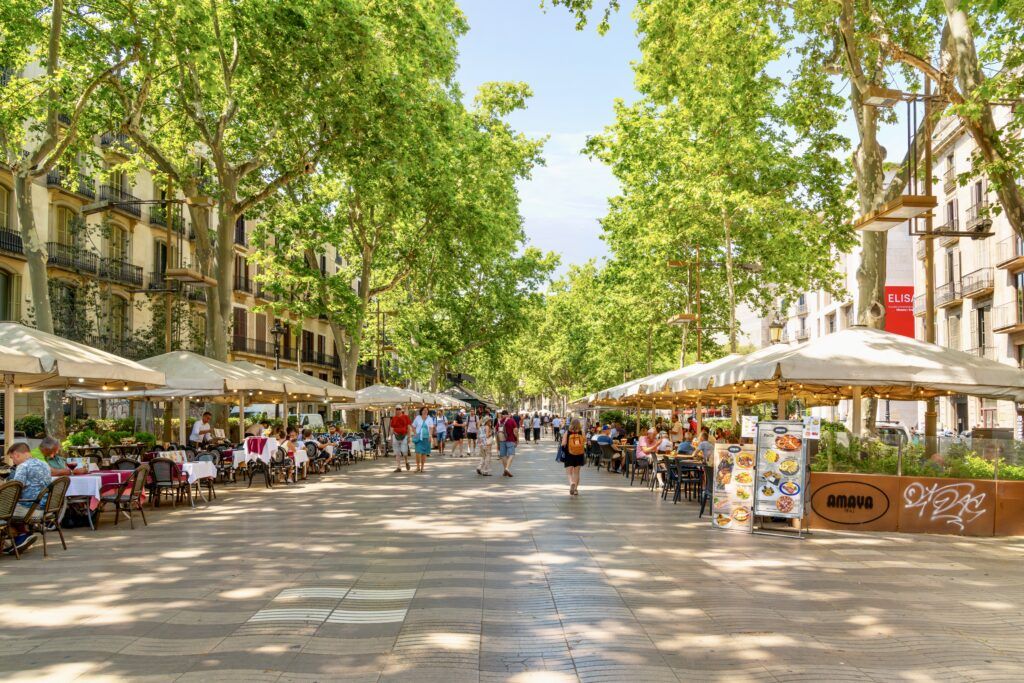
5 Days In Barcelona Itinerary: What To Do
Start at Placa de Catalunya. It’s one of the city’s most bustling squares, and a central meeting point.
La Rambla
Have a coffee at Cafe Zurich.
Then go with the flow down the 3/4 mile stretch of La Rambla.
La Rambla is Barcelona’s drawing room, a lively pedestrian boulevard. The street is not just ancient buildings. It’s a colorful parade of flower stalls, artists, and posing human statues.
Along the way, you can admire some of the city’s prettiest squares, the ruins of the Temple of Augustus, the Church of Santa Maria del Pi, and some museums.
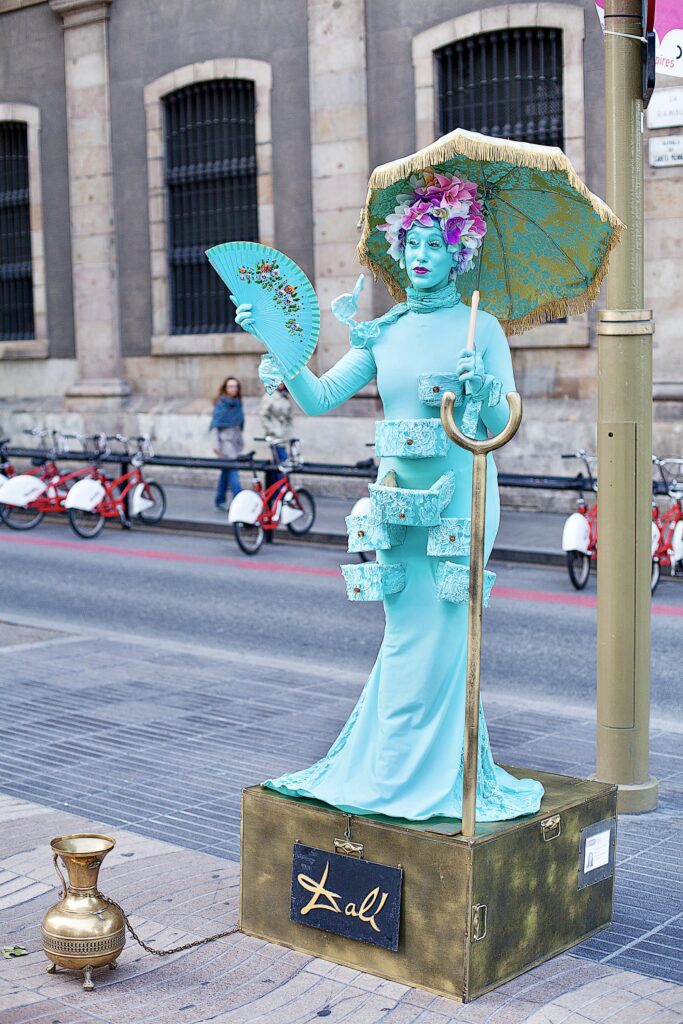
Plaça Reial is known for its lively atmosphere, and is lined with palm trees, restaurants, and bars.
The square features a beautiful fountain in the center, and is famous for the lampposts designed by the young Antoni Gaudí.
If you’re a history buff and want to see the remains of the ancient Roman city of Barcino, stop in at the Barcelona History Museum in Placa del Rei.
>>> Click here to book a Gothic Quarter walking tour

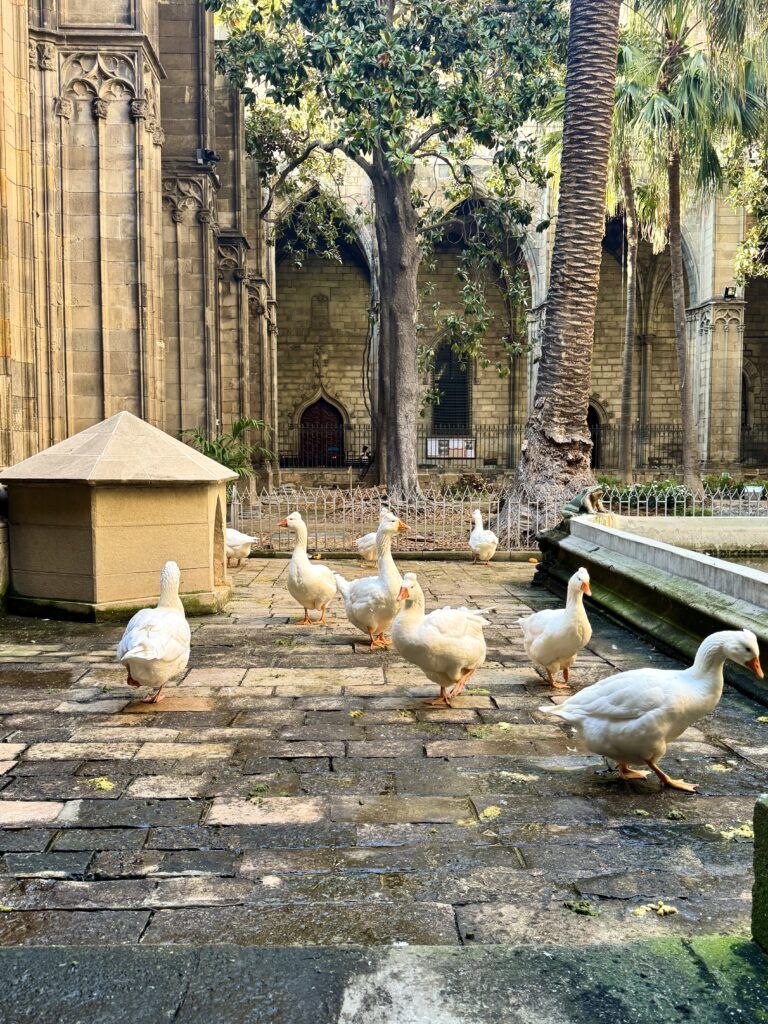
Barcelona Cathedral
One must visit in the Gothic Quarter is the cathedral. It’s a Neo-Gothic structure in Placa de la Seu, based on a 15th century design.
The facade is covered in stone lacework, pinnacles, gargoyles, and other ornate designs. Inside, it’s much more austere.
You’ll want to stroll through the chapels, admire the wooden choir, take the stairs down to the crypt, and visit the geese-filled cloister.
I recommend hoofing it up to the rooftop. You can see some of the tower details up close and you’ll get nice city views.
You may also want to book a guided tour to get the complete historical backdrop.
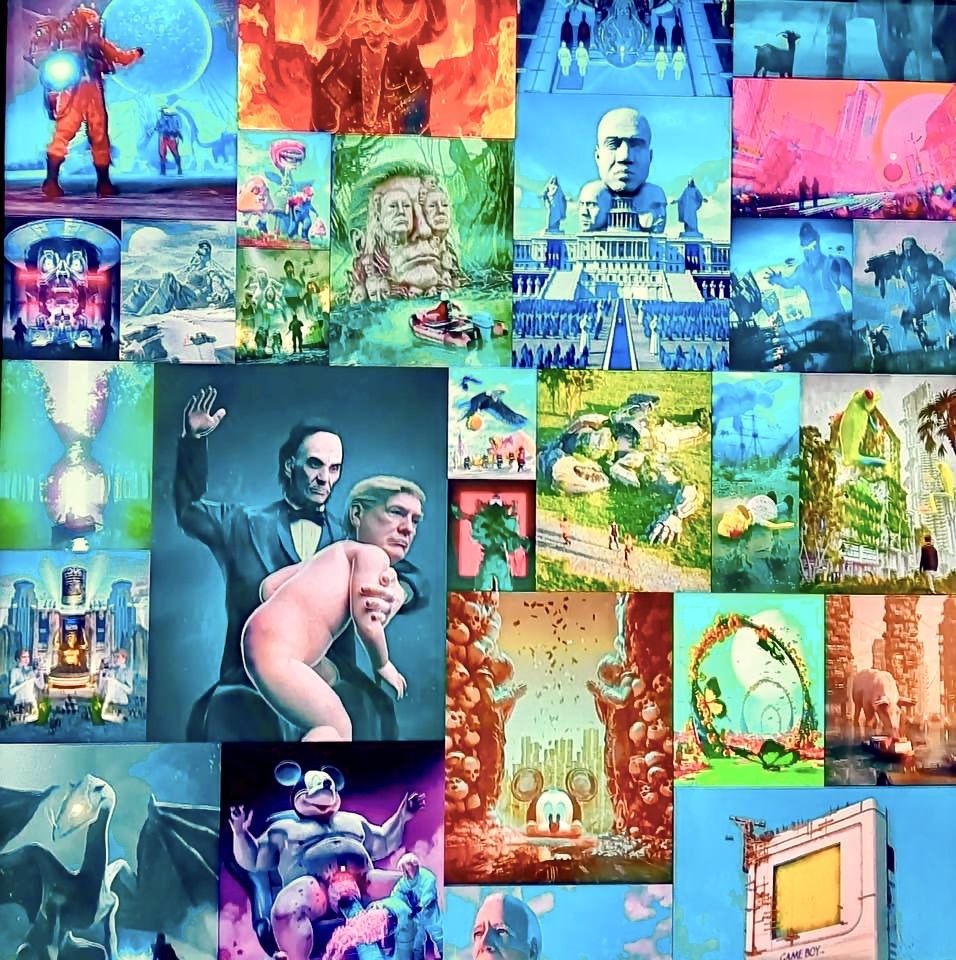
Boqueria Market
For lunch, stop in to Boqueria Market. It will be mobbed, but try not to put off by the crowds or the over-stimulation.
The market is a cacophony of chicken, live snails, stiff fish, jamon, olives, and odd odors.
You can sample the goods as you wander through the market, settle down at a small cafe, or get some things for a picnic.
If you want to sit down, I recommend Bar Pinotxo and El Quim de la Boqueria.

Palau Güell
After lunch, visit Palau Guell. It’s one of my favorite Modernist spaces in the city. It’s an early Antoni Gaudi building.
It’s nothing like the more famous Cars Batllo, but still well worth a visit.
It’s dark and moody with Moorish and Modernist vibes. Right at the entrance, you’ll see hyperbolic arches with Modernist wrought iron,
Inside, the house has gorgeous lamps, coffered ceilings, stained glass, and some period furniture.
Gaudi’s experimentation is evident mostly in the basement and on the rooftop. There’s an organ too, and it plays classical music every half hour.
>>> Click here to pre-book a ticket

El Born
Spend the evening in the El Born neighborhood.
There are plenty of outdoor cafes for a cocktail.
Some restaurants I recommend in El Born and El Raval are:
- El Xampanyet: bustling tapas bar famous for its traditional Catalan dishes and sparkling cava
- Dos Pebrots: creative takes on Mediterranean cuisine (Persian kebab was amazing!)
- El Chigre: heaps of seafood (try the octopus with chimchurri seaweed)

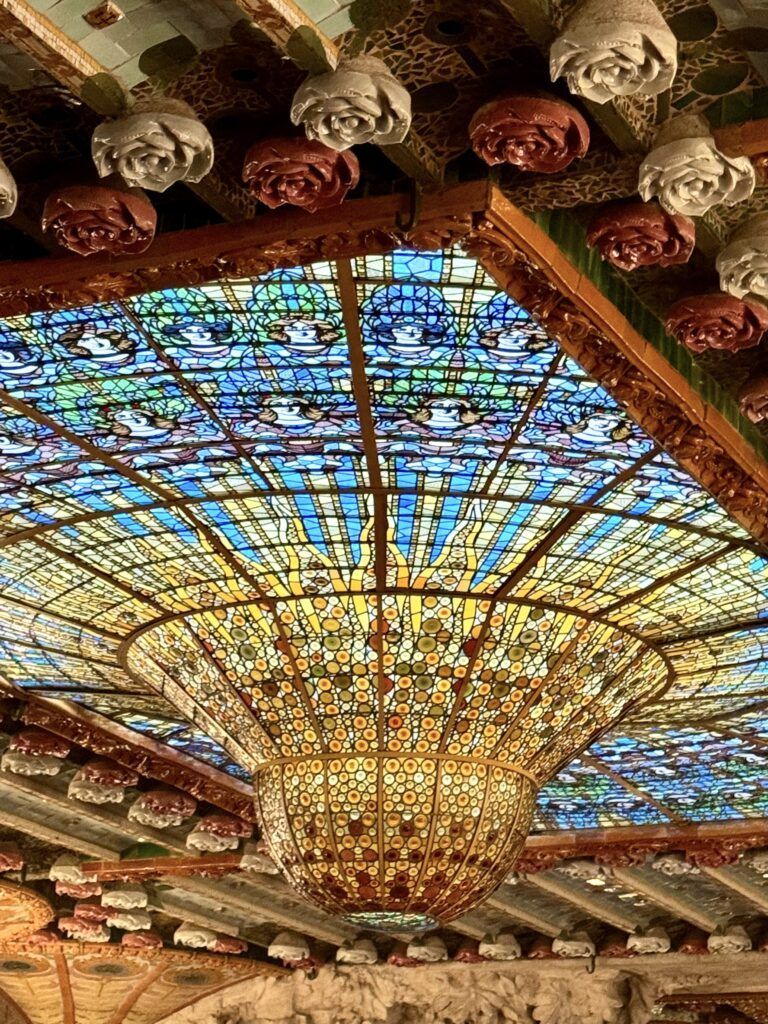
Palau de la Musica Catalana
Start your second day in the city with a visit to Palau de la Musica Catalana. It’s a gorgeous space, one of the prettiest interiors in the city.
The palace was designed by Domenech i Montaner and its his most extravagant effort. Today, it serves as a concert hall, with all kinds of music and performances.
You can visit on your own or with an audio guide.
Along the way, you’ll see the beautifully decorated lower level and cafe area, the concert hall, the Millet gallery, and a few other rooms.
The highlight is the auditorium. It’s home to a gorgeous skylight and is encrusted with sculptures, mosaics, wrought iron lamps, and stained glass.
>>> Click here to pre-book a ticket
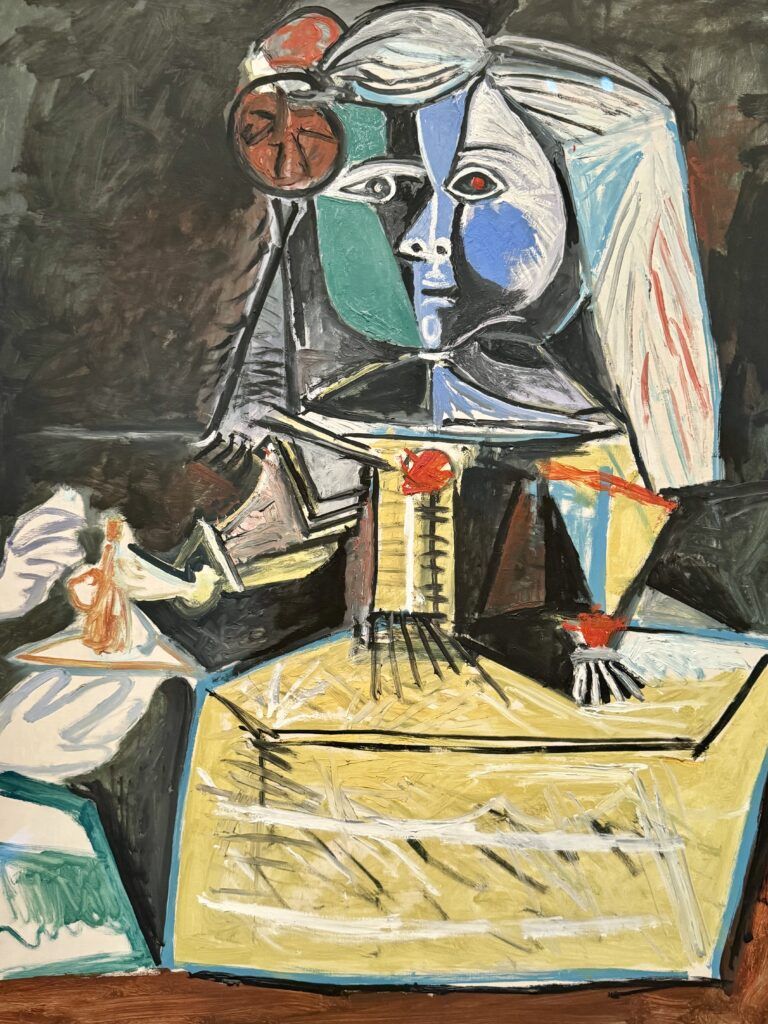
Picasso Museum
The Picasso Museum is the most popular museum in Barcelona. It’s housed in several gorgeous medieval palaces.
It holds a unique collection — the early works of Pablo Picasso, his riffs on Diego Velazquez’ Las Meninas, and some late-in-life-ceramics.
However, there are no major masterpieces.
If you’re a Picasso fan, the museum is a must visit just to see his boy wonder works. If you’re not, don’t feel compelled to go. It’s very crowded and that may be enough to dissuade you.
>>> Click to pre-book a timed entry museum ticket
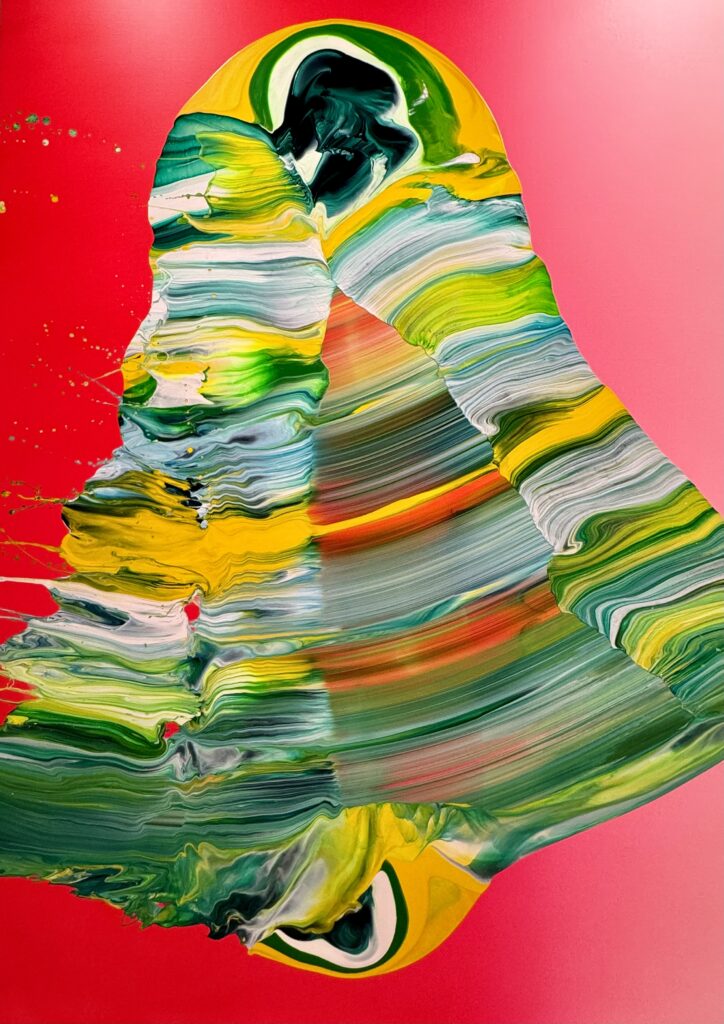
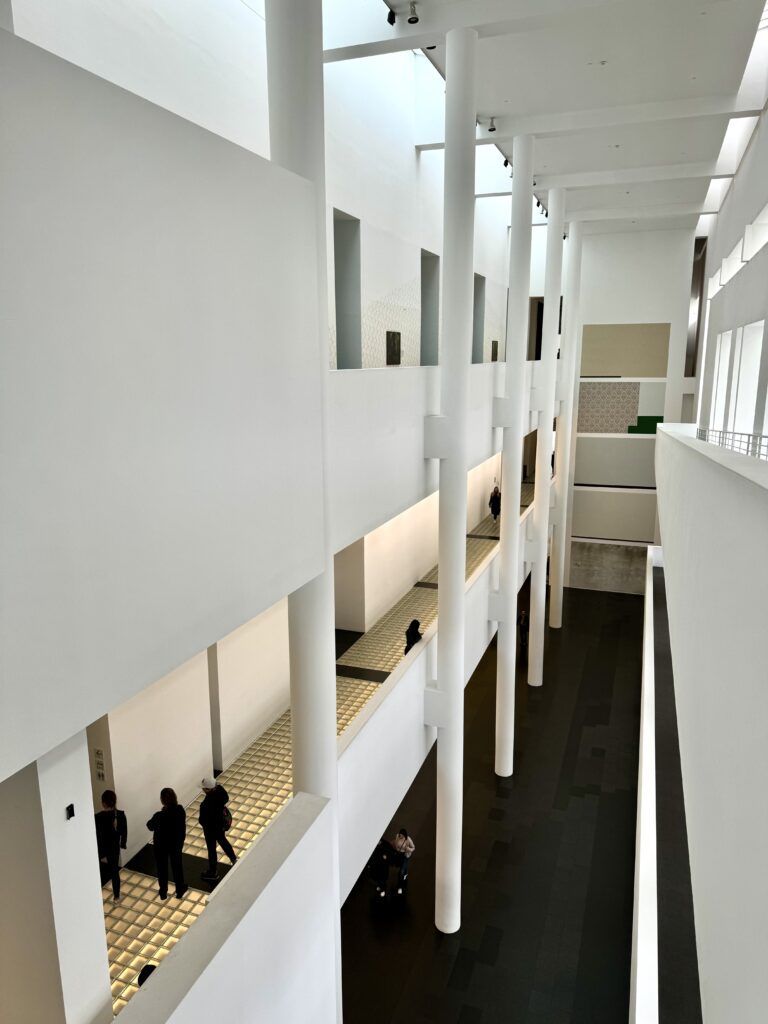
MOCO, Bansky Museum, or MACBA
If you want to skip the Picasso Museum, there are plenty of other options nearby!
MOCO is a modern and contemporary arts museum in a beautiful palace. It’s a gorgeous museums pace with plenty of Instagrammable art. I absolutely loved it!
You’ll find works by the usual luminaries — Dali, Banksy, Kaws, Jeff Koons, and Salvador Dali. But there are also works by lesser known artists that were gorgeous, like the pieces by Guillermo Lorcas.
The museum also has some immersive exhibits. One room will remind you of the infinity rooms of Yayoi Kusama.
>>> Click here to pre-book a ticket

Another grab option is the newly-opened Banksy Museum.
If you’re a fan of the street artist, this museum may be your best bet. Though there are Banksy works in MOCO as well.
A bit further away is the MACBA Museum. This is Barcelona’s cutting edge contemporary art museum.
Richard Meier designed the light-filled building and I think the architecture is the star of the show here.
There are some works in its permanent collection. But the museum principally hosts contemporary exhibitions.
Much of it is conceptual art, so this is the museum for you if you like avant garde art. In high season, you should pre-book a skip the line ticket.
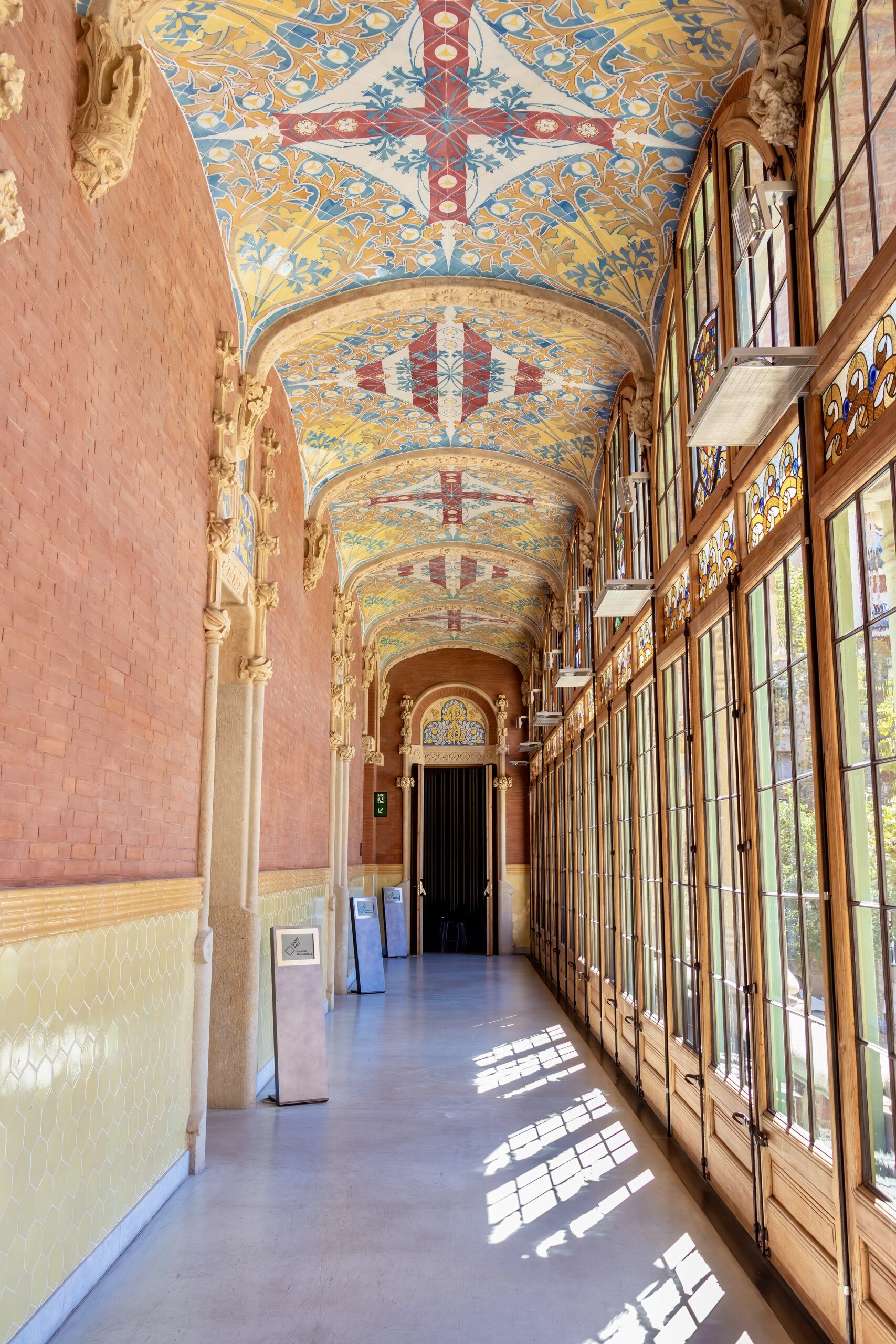
Hospital de la Santa Creu i Sant Pau
This distinctive Modernist complex was designed by Domenech I Montaner. It was intended to be a holistic hospital with wards, a garden, and a library.
The hospital has since been removed to new digs. Today, the building is essentially a landmark of Modernist architecture.
If you’re a fan of Modernism, it’s a great stop.
When you’re done, hit a rooftop bar for cocktails. Or head to a flamenco show (before or after dinner)
Eixample
The vast and gridded Eixample area buzzes with life, day and night.
The Passage de Gracia is a grand old street, lined with Modernist mansions, high end shops, and upscale eateries and cute cafes.
This is also where you can do your designer shopping.
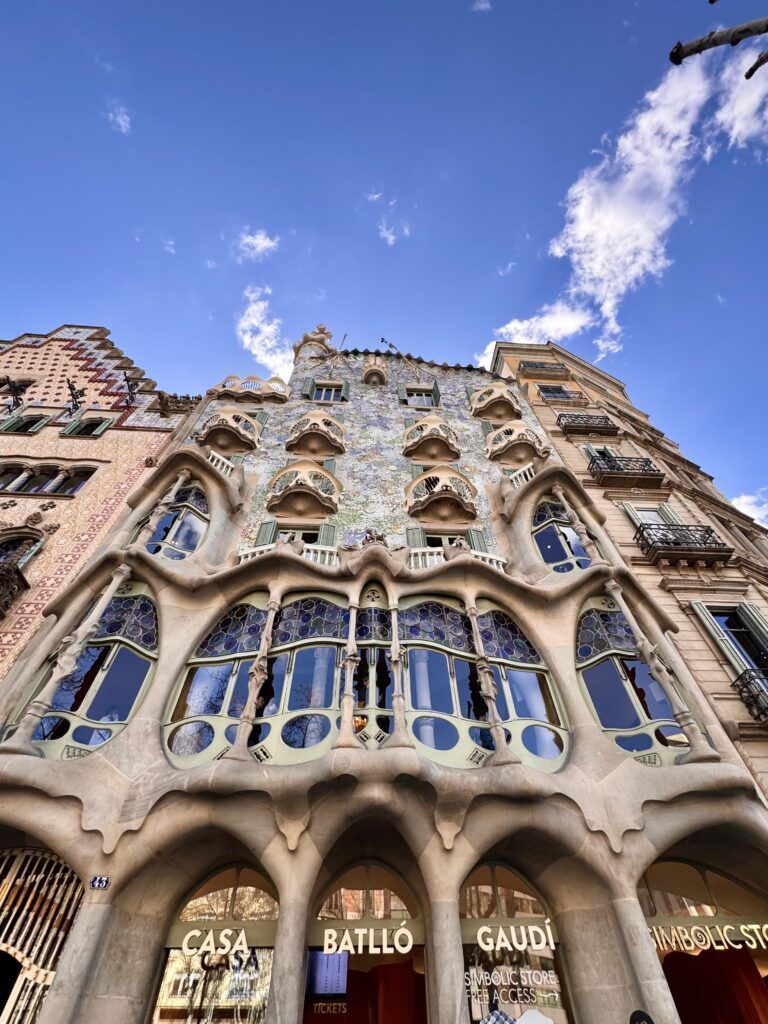
Casa Batllo
The most famous Modernist start is right on the street, Casa Batllo. It’s an Antoni Gaudi work, with one of the most interesting facades you’ll ever see.
Gaudi’s theme was St. George and the Dragon. St. George is the city’s patron saint.
According to legend, he slew a dragon that was terrorizing the city by eating its citizens. George saved them from all that.
Gaudi’s facade looks like an actual dragon. The walls or “skin” are covered in scaly mosaics.
The long windows on the first floor are propped up by shin bones. Above them are jaw-like balconies. On the roof, is a knife being plunged into the dragon.
It’s all quite wacky. And because of that people flood in to visit.
Inside, you’ll find sinuous curving wood, beautiful stained glass, and a colorful rooftop with a cafe.
You’ll need to pre-book a timed entry ticket and show up at least 15 minutes early to get in the correct time for your time slot.
You can also book a guided tour or visit at night.
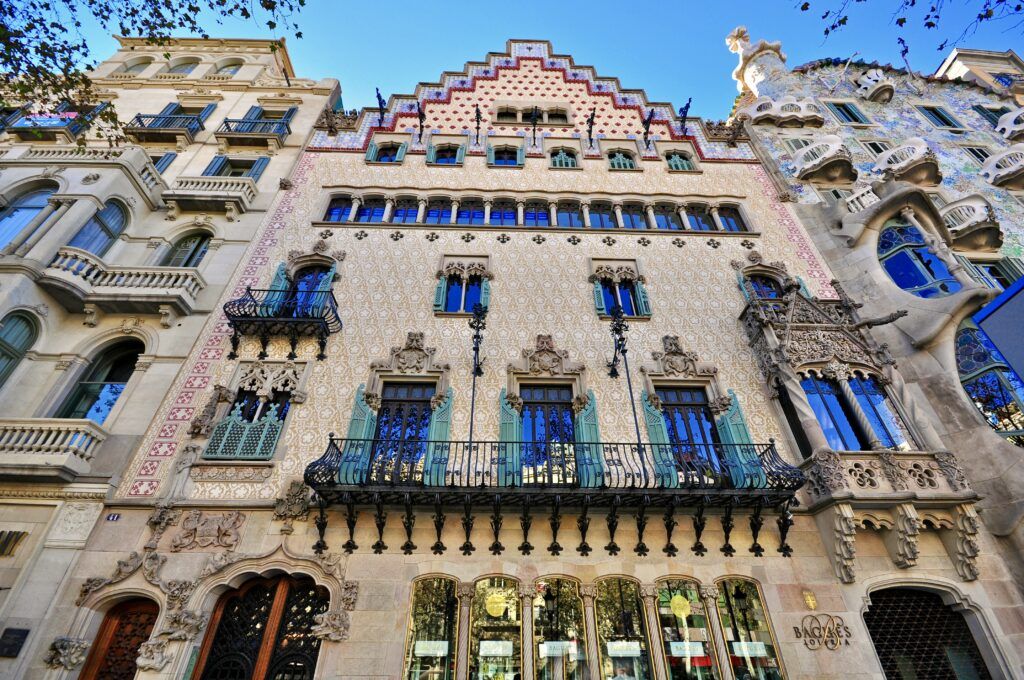
Casa Amatller
Casa Amatller is right next door to Casa Batllo and seems a bit ignored. It was designed by another famous Modernist architect, Josep Puig i Cadafalch.
Like Casa Batllo, it has a stunner of a facade. It has frilly Gothic wrought iron balconies and an unusual steepled gable.
You can only visit on a guided tour. They leave on the top of the hour.
The nice thing about this Modernist gem is that it displays the original furnishings of the Amatller family.
They’re set amid coffered ceilings, stained glass, wrought iron chandeliers, and intricate sgraffito and wallpaper.
If you can’t get into Casa Batllo, this is a great alternative!
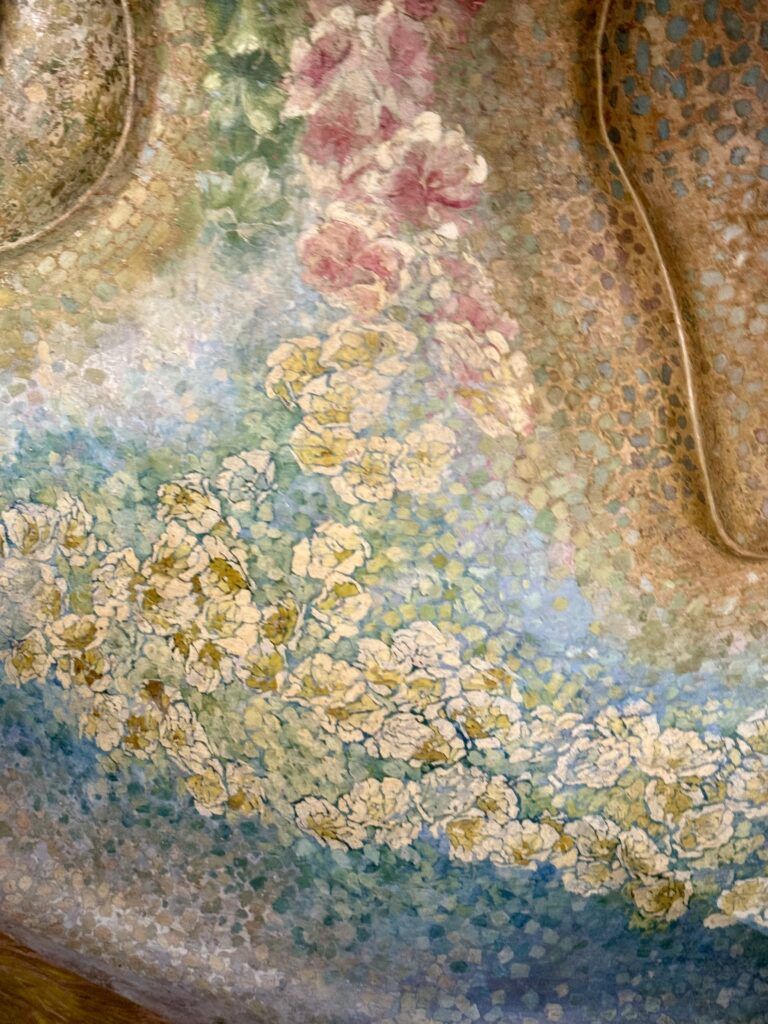
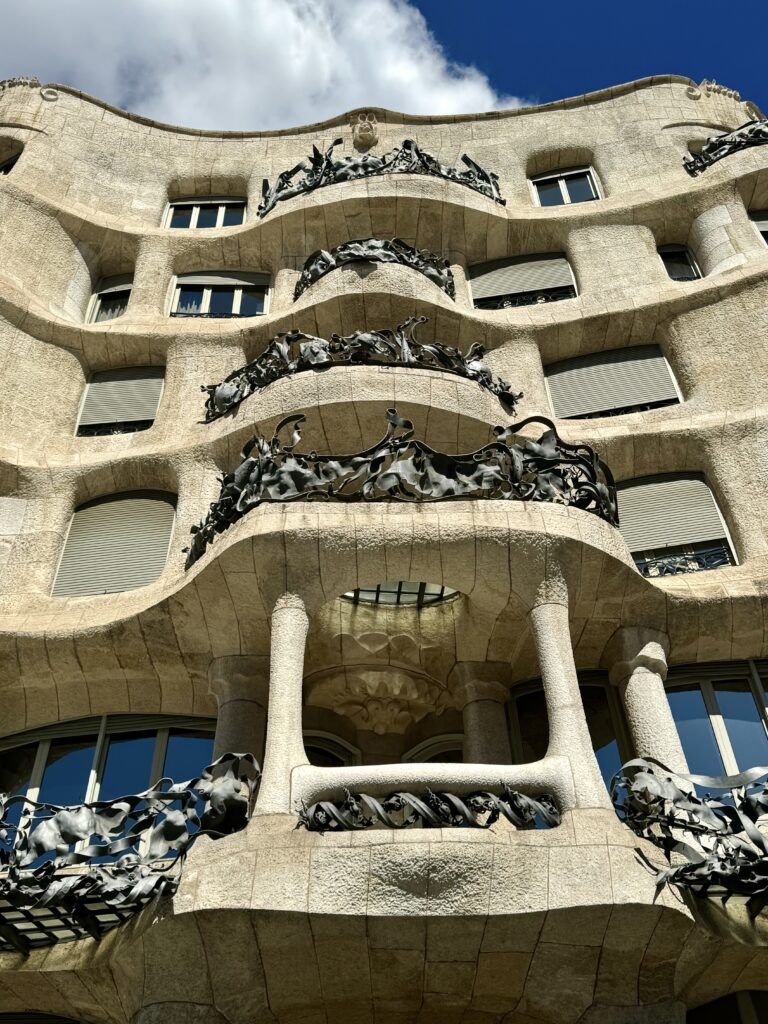
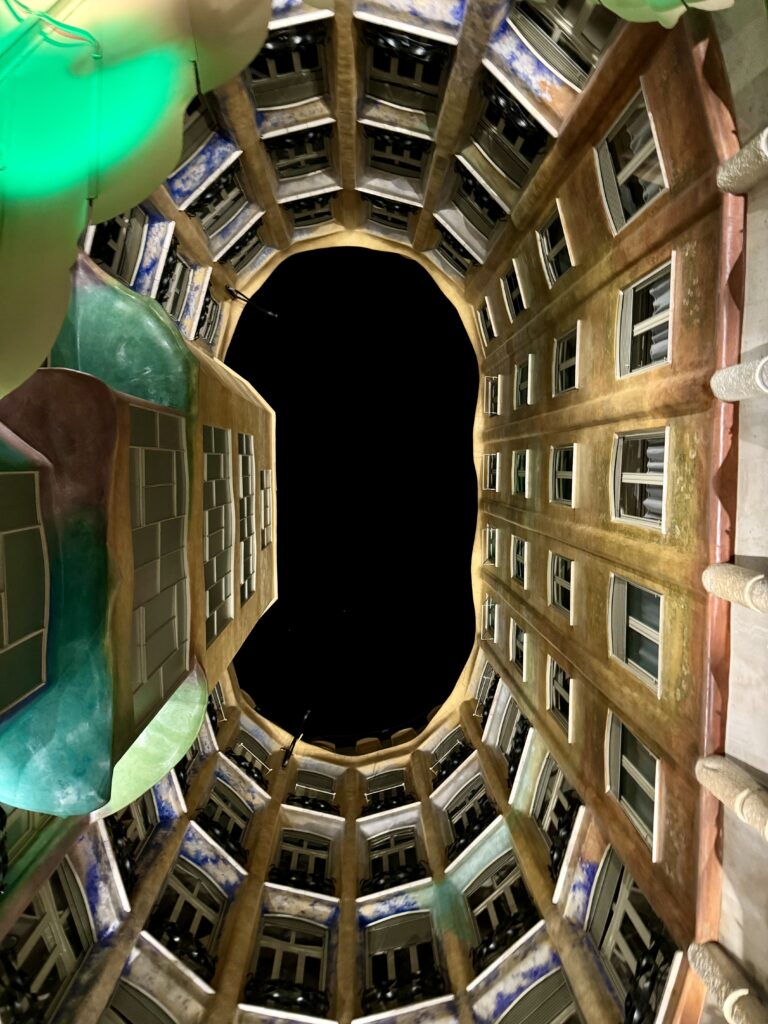
La Pedrera
La Pedrera, also known as Casa Mila, is Gaudi in his mature, completely in command stage.
Unlike Casa Batllo, Gaudi was given carte blanch to build this from the ground up. He created a facade that undulates like the sea and is covered in seaweed-like balconies.
Inside, there is plenty to explore — two central courtyards, an attic, and the glorious rooftop. One courtyard, the oval one, has a balcony that looks like a bird.
The rooftop is the swishiest in the city. It’s filled with Star Wars-like chimneys and colorful organic forms.
You can visit on your own with a skip the line ticket or take in the sound and light show at night. Then, the rooftop is lit up with a light show called “Origins,” which gets you into Gaudi’s vision.
Casa Vicens
After La Pedrera, take a walk down the Gran de Garcia until you reach Casa Vicens. This lively house will make you want to move right in.
It was Gaudi’s first residential commission. The exterior is covered in beautiful shades of red and green in Moorish designs and decorated with sunflowers.
Inside, you can explore three floors and the roof. There’s a gorgeous dining room, patio with a burbling fountain, and blue tiled smoking room.
As with everything Gaudi, it’s full of floral and nature motifs.
>>> Click here to pre-book a tour in high season

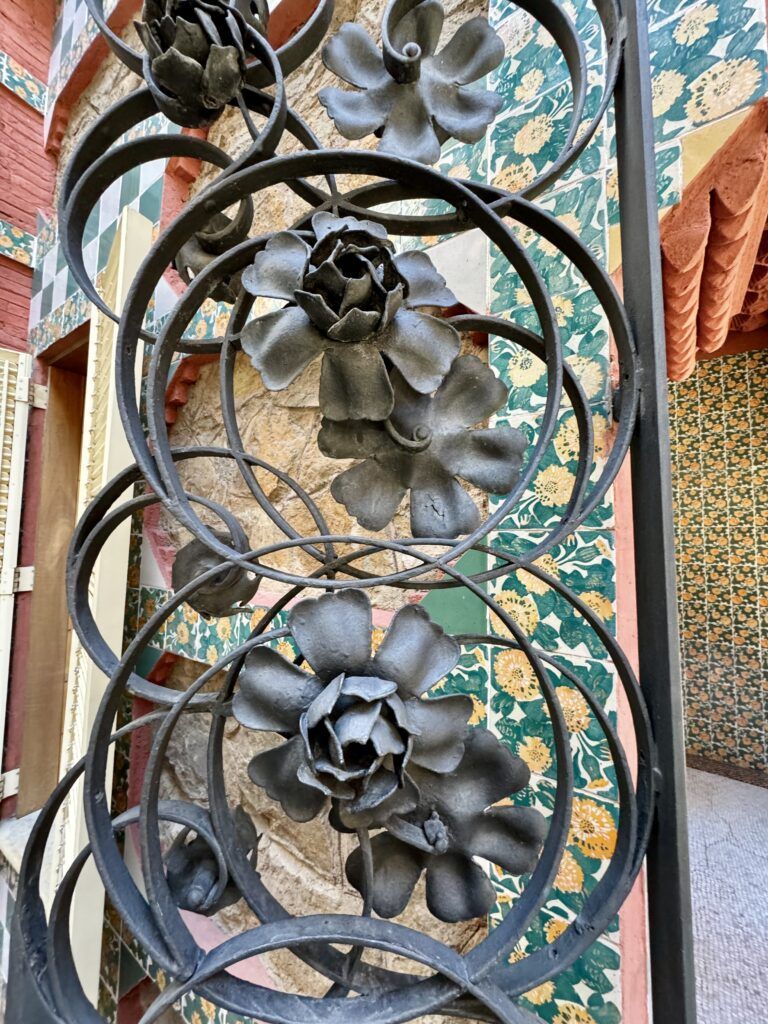
Gracia
While you’re there, spend the evening in the Gracia neighborhood. There’s some beautiful architecture and great cafes and bodegas.
For dinner, La Ceba makes 50 kinds of tortillas, which is a traditional Spanish omelette bulked out with potatoes.
Verbena has a regularly changing menu adored by local foodies.
And Sol Soler is a nummy tapas bar the locals recommended to me.
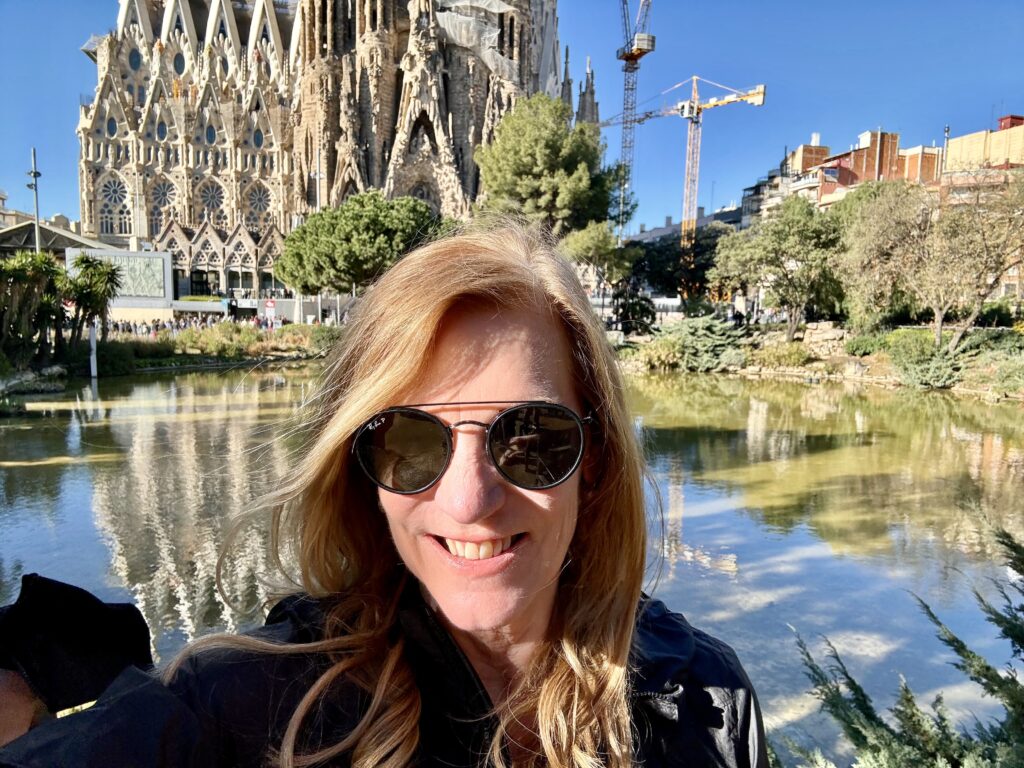
Sagrada Familia
Start day 4 of your 5 days in Barcelona off with a bang with a visit to Sagrada Familia. It’s the #1 attraction in Barcelona and an icon of the city. It’s Gaudi great unfinished masterpiece.
The basilica boasts wildly creative, unmistakably organic architecture, both inside and out.
When finished, this mega church will have 18 spires. In the center will be the 560 foot Jesus tower, shining like a spiritual lighthouse.
There are three facades, only two complete.
You enter through the gorgeous Nativity Facade and exit through the more severe Passion Facade. The Glory Facade will one day be the main entrance.
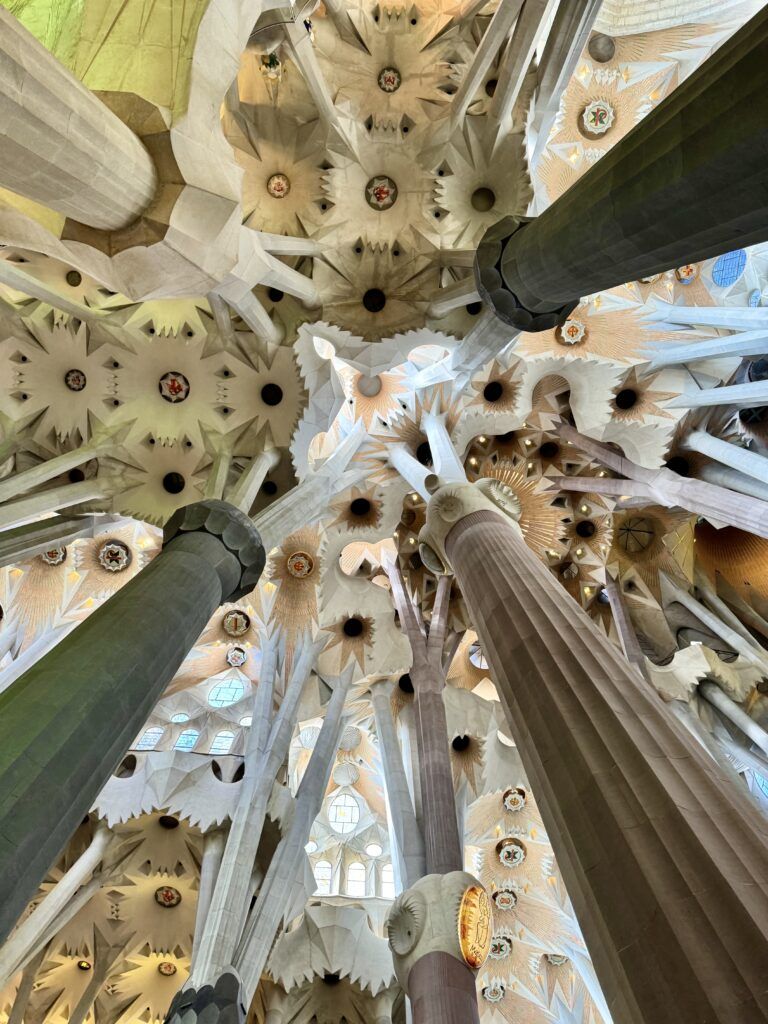

Inside, you’ll be slack jawed. It’s hard to believe how beautiful it is — a starry forest of columns and stars.
All tickets are timed entry. You can book online at the official website or buy a ticket through Get Your Guide.
The base price is 26,00 € or 36,00 € with a tower visit.
You can take up elevator up to the Passion Facade or Nativity Facade, which are not joined. The Passion tower is high and gives you views across the city.
The elevator is only one way. You’ll have to hoof it down.
One of the best places to snap exterior photos is from Plaça de Gaudí, located just across from the basilica. This small park features a pond that offers a reflective view of Sagrada Familia.

Park Guell
Park Güell is an incredibly popular tourist attraction in Barcelona. It’s touted as the site where Gaudi was most imaginative. He created a whimsical dream-like park with a one-of-a-kind terrace.
Gaudi was originally commissioned to create a suburban community. But funds ran out, and it was turned into a delightful park.
There are gingerbread style houses, an undulating serpent-inspired balcony a grand staircase guarded by a colorful dragon, and a hypostyle market space with Doric columns and ceramics.
There are two houses. One contains a gift shop and the other contains the La Casa del Guarda.
This is a small museum and branch of the city’s history museum. I’d say it’s entirely skippable. Plus, you’ll have to line up and wait to get in.


In general, prepare for heavy crowds. In my opinion, this make the site somewhat overrated.
Nonetheless, the stunning tile work and unique architectural style are impressive and well worth seeing, especially if you go early or later to avoid throngs of people.
As with any major Gaudí site in Barcelona, it’s crucial to purchase ticket ahead of time to bypass long lines. The park allows 400 visitors every 30 minutes.
Although that may seem like a lot, tickets often sell out quickly, especially early in the day. So, I would definitely pre-book a timed entry ticket or book a guided tour.
I visited on a guided tour. It was a convenient way to get to the park. But I wouldn’t say you really need one, especially if you have access to the hop on hop off bus.

Tapas Tour
In the evening, consider doing some tapas hopping on your own or joining a guided tapas tour.
There are a huge variety of guided tours. I took this 3 hour tour in El Born and loved it.
Another good place for an evening tapeando is the San Antoni neighborhood. It’s Barna’s best kept secret and the perfect place for a bite-sized feast.
The charming barri dates back to the 15th century. But it was the opening of the food market that made the area famous.
Today, it’s a foodie hotspot with family run tapas bars, cozy bodegas, and a warm welcome.
You can grab a vermouth cocktail at Rekons, have some fancy tapas at Els Sortidors del Parliament, and some traditional tapas at Bar Calders.

Spend your last day in Montjuic Hill. The easiest way to get there is to take the cable car.
Montjuic offers a mix of cultural, historical, and recreational attractions. It overlooks the city and the harbor, providing stunning panoramic views of the city.
Montjuic Castle
Built in the 17th century, this historic fortress has seen many roles, from a military stronghold to a political prison.
Now open to the public, it’s a window into Barcelona’s past, perfect for history buffs. The museum explores the city’s strategic importance during various conflicts, including the Spanish Civil War.
You can see ancient military installations, art exhibitions, and attend cultural events.

Miro Foundation
If you’re a fan of Joan Miro (I know I am), you’ll want to visit his eponymous museum, the Joan Miro Foundation.
It’s a personal collection that Miro donated to the museum. It’s all housed in a white, light-filled building designed by his friend Josep LLuis Sert.
You can see the evolution of his art. There are plenty of pieces from his mature celestial period with images of birds, women, and sun.
You can also step out into an outdoor sculpture garden with whimsical sculptures in blue, red, and yellow. You’ll see people taking selfies with them.
>>> Click here to pre-book a Miro ticket
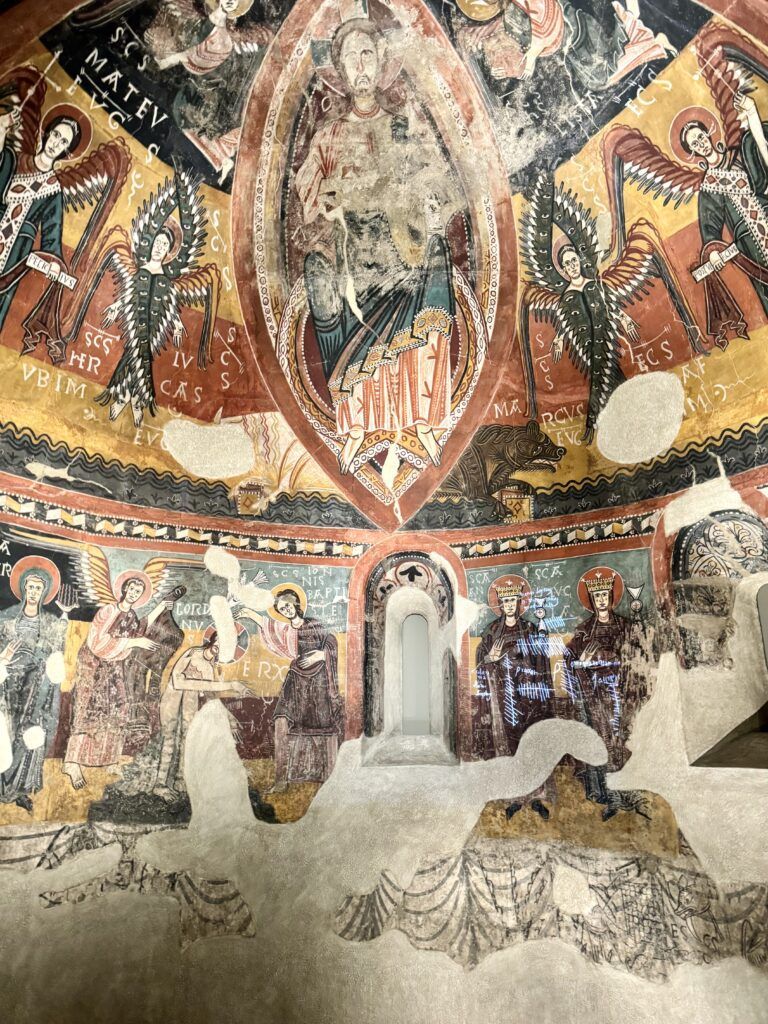
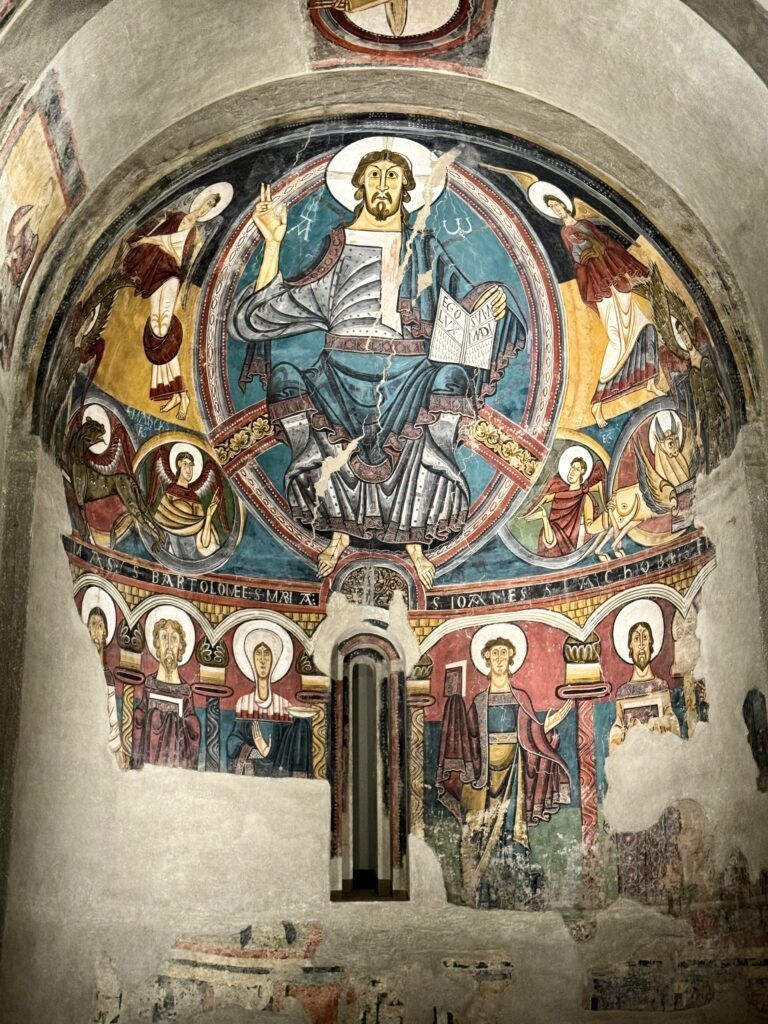
Museum of Catalan Art
The other standout museum in Montjuic is in the Neo-Baroque palace you’ve probably seen in photos — the National Museum of Catalan Art (“MNAC”).
The museum is well laid out and separated into four parts: Romanesque, Renaissance & Baroque, and two modern areas. You’ll need to scan your ticket to enter each gallery.
To me, the best part of the museum is the Romanesque section. It houses gorgeous (and rare!) Romanesque style murals in purpose built apses and niches.
They’ve been beautifully restored. And the saints don’t even look too alien-like as you often see in medieval art.
You can also sit down and admire the Oval Room and take the elevator or hike up to the roof for views.
>>> Click here to pre-book a MNAC ticket
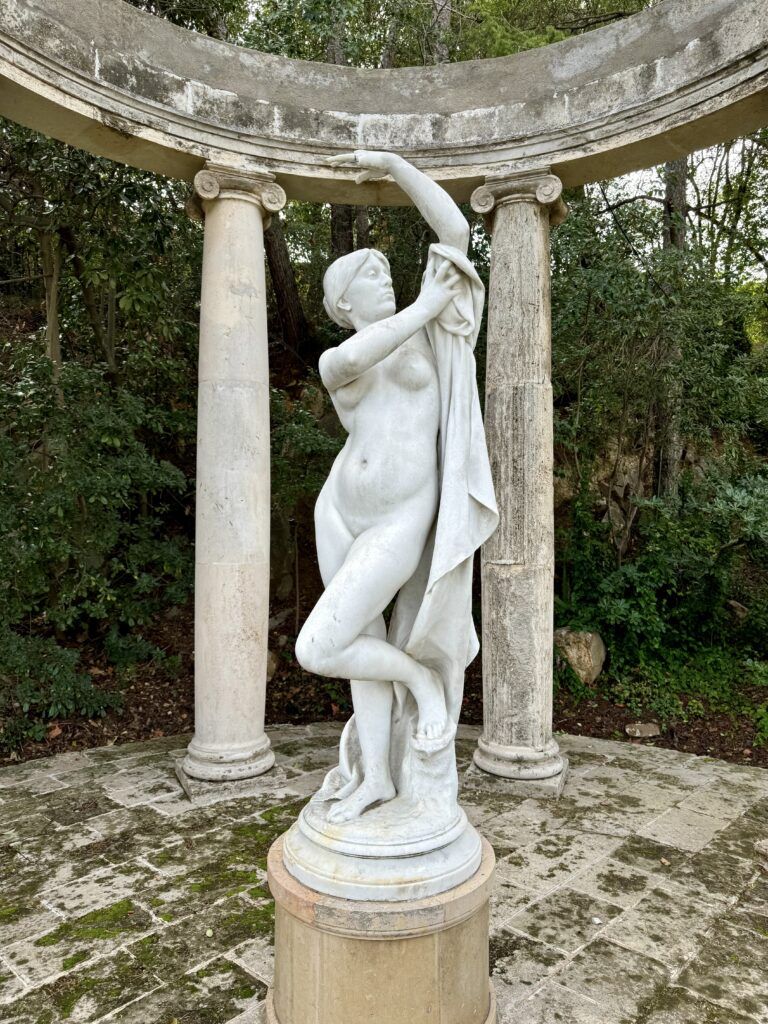
Laribal Gardens
After your museum visit, decompress with a walk through some of the lovely gardens on Montjuic.
The Laribal Gardens is the most serene and artistic space. These gardens were designed for the 1929 International Exhibition by French landscape architect Jean-Claude Nicolas Forestier and his collaborator Nicolau Maria Rubió i Tudurí.
The design blends traditional Andalusian and Moorish garden elements with modernist touches.
The gardens are famous for their terraced landscapes, winding paths, and exquisite water features, including fountains and cascading pools.
Notable features include the Font del Gat, beautiful tiled benches, and sculptures and busts that pay homage to Catalan culture

Mies van der Rohe Pavilion
On your way back down from the hill, you can stop into the Mies van der Rohe Pavilion.
It’s a small folly that was built by the modern architect for the World Exposition. It was later town down, as was planned. But was then rebuilt.
It’s actually a lovely space emblematic of Miles’ style. Luxe materials are artfully arranged to emphasize flow and movement.
There are reflection pools in the front and sides, one with a photogenic sculpture by Georg Kolbe, a van der Rohe contemporary.

Magic Fountain
If you stay in Montjuic or the evening, you can take in the Magic Fountain light show.
The show show that combines colorful lights, choreographed water jets, and a synchronized soundtrack.
Check the website for exact times and dates. In the summer, the show is at 9:30 pm and the winter it’s at 8:00 pm on certain days.

I hope you’ve enjoyed my 5 days in Barcelona itinerary.
If you want more tips on where to eat, where to stay, how to get around, and what city passes to buy, check out my article on tip, tricks, and hacks for visiting Barcelona.
You may find these other Barcelona travel guides helpful:
- 1 day in Barcelona itinerary
- 2 days in Barcelona itinerary
- 3 days in Barcelona itinerary
- what to do in the Gothic Quarter
- best museums in Barcelona
- hidden gems in Barcelona
- landmarks in Barcelona
- guide to architecture in Eixample
Pin it for later.


